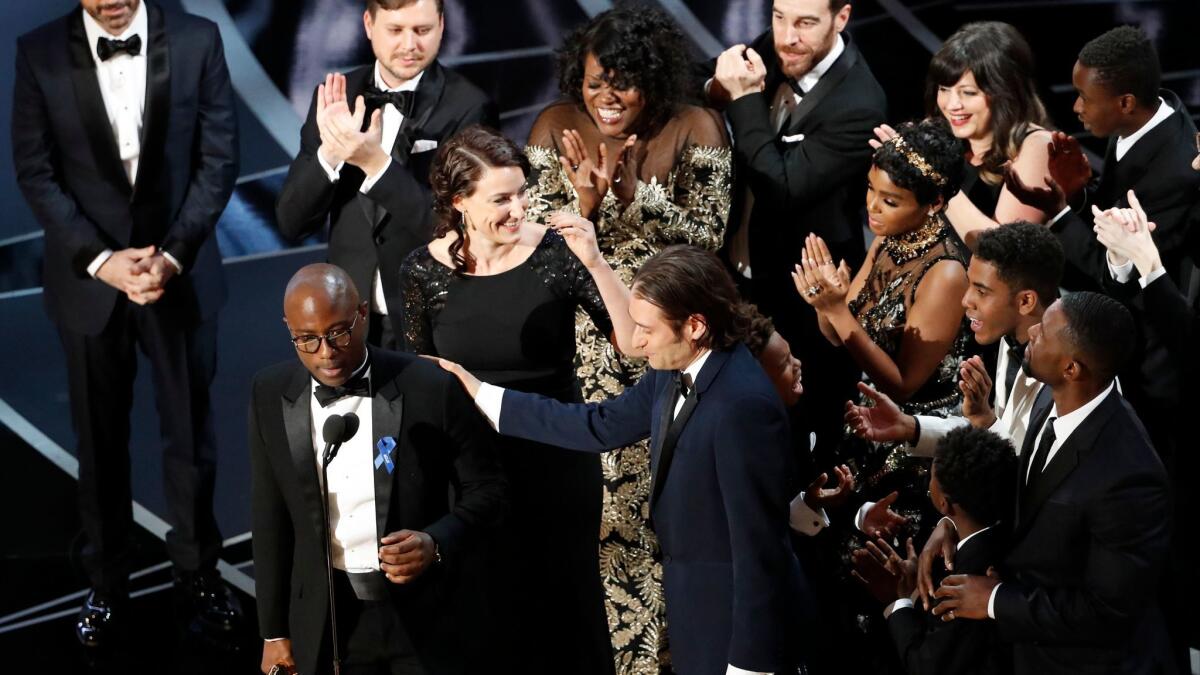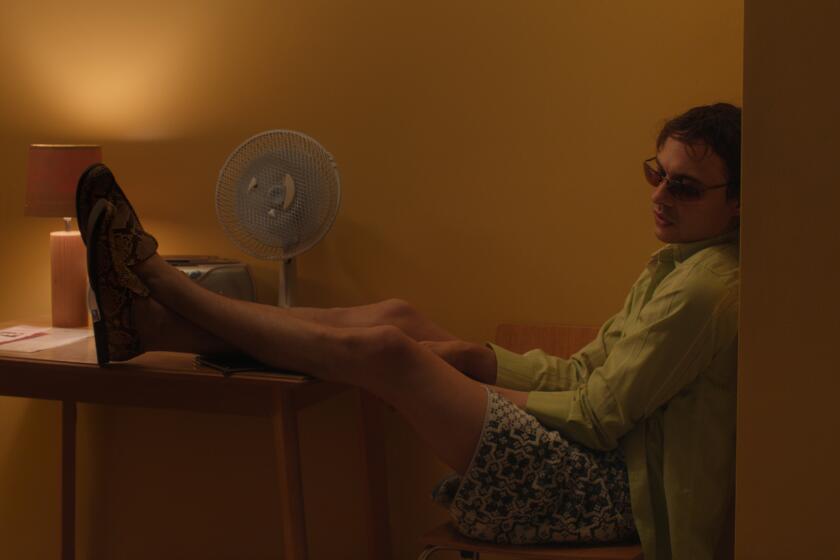How ‘Moonlight’s’ Oscar win blew another hole in the definition of ‘best picture’

- Share via
Even if last year’s Oscars ceremony hadn’t ended with the most embarrassing gaffe in the Academy of Motion Picture Arts and Sciences’ nearly 90-year history, the announcement that “Moonlight” had won best picture still would have come as an industry-rattling shock.
Everyone had expected an easy win for “La La Land,” which had entered the night with a pack-leading 14 nominations and key precursor awards. A star-driven throwback to vintage musicals, Damien Chazelle’s movie was considered much more in line with academy tastes than a gritty realist drama about a young black man’s impoverished Miami upbringing.
For the record:
4:25 p.m. Feb. 28, 2018A previous version of this post said that “Moonlight” was produced on a $4-million budget. It was a $1.5-million budget.
In its unblinking view of race, homosexuality and frustrated masculinity, “Moonlight” cut against deeply ingrained industry prejudices about the kinds of films that can expect to compete for Hollywood’s highest honor. Produced on a shoestring $1.5-million budget, it was regarded even by its admirers as too small, too arty, too niche and, frankly, too good for the Oscars — a soulful heartbreaker in a contest that typically favors splashy crowd pleasers.
No one, in short, saw “Moonlight” coming. But the shock of its 11th-hour victory, for all the confusion of the surrounding circumstances, brought with it a welcome jolt of clarity. Its win represents the latest development in a long, steady evolution for a motion picture academy that no longer behaves as stodgily or predictably as we’ve come to expect.
From ‘Get Out’ to ‘Phantom Thread’: The 2018 Oscars Buzzmeter »
One step forward has certainly been the academy’s dramatic recent efforts to diversify its predominantly white male makeup following the widespread #OscarsSoWhite criticisms that arose in 2015 and 2016. But it would be reductive and premature to assume that the membership overhaul, a process that remains very much in its early stages, helped push “Moonlight” to victory.
Another factor is the ever shifting dynamics of film discussion in the internet age (which helped turn #OscarsSoWhite into a rallying cry). Awards season, already interminable for those who follow it, has become a protracted opportunity to digest and redigest the same movies again and again, to circulate reviews, think pieces, points and counterpoints endlessly on social media. It’s a process that continually seeks change and renewal, dislodging frontrunners and elevating underdogs for the mere sake of keeping the conversation fresh.
But in all likelihood, the most significant shift in the best picture Oscar algorithm has been simple mathematics. In 2009, the academy announced that, for the first time since 1945, the best picture category would boast 10 nominees rather than five. (Two years later, the rules were tweaked again to accommodate anywhere between five and 10 picture nominees; that system remains in place today.) With this expansion, the organization also reinstated a preferential ballot that allows members to rank all the best picture nominees, rather than simply vote for one favorite.
That arrangement almost certainly accounts for the recent disparities between the picture and director categories, a once infrequent occurrence — few films won best picture without first winning best director — that has now become commonplace. The rationale behind these splits has been surprisingly intuitive, even discerning: While the academy has recently handed its directing prizes to bravura technical achievements such as “Gravity,” “The Revenant” and “La La Land,” it tellingly chose to give best picture in those corresponding years to “12 Years a Slave,” “Spotlight” and “Moonlight” — dramas that were smaller in scale and budget, perhaps, but arguably larger in emotional depth and social-political resonance.
Even when there hasn’t been a picture-director split, we’ve seen a welcome shift in perspective: No longer do voters automatically equate the biggest with the best. It would be hard to find a more suitable David-and-Goliath metaphor than the triumph of Kathryn Bigelow’s low-budget, low-grossing Iraq War thriller, “The Hurt Locker,” over James Cameron’s record-shattering 3-D blockbuster “Avatar” in 2010. The 2012 best picture win by “The Artist,” Michel Hazanavicius’ loving ode to silent filmmaking, may not have aged quite as well, but it, too, exemplifies the academy’s willingness to dismantle easy assumptions of what a best picture can be.
Full list of 2018 Oscar nominations »
The effects of this sea change are being felt in this year’s particularly wide-open race. Special arrangements have doubtless been made to ensure the integrity of the envelopes, but the more lasting legacy of last year’s upset can be seen in the unusual inscrutability of the best picture tea leaves. No single film has completely dominated the proceedings leading up to the ceremony, and pundits have been more reluctant than usual to make definitive pronouncements.
The closest thing to a frontrunner would appear to be Guillermo del Toro’s lavish Cold War-era fantasy “The Shape of Water,” which, echoing “La La Land” last year, won the Producers Guild of America and Directors Guild of America awards and has more Oscar nominations (13) than any other contender. But while Del Toro is widely expected to win best director, many are predicting a best picture win for Martin McDonagh’s bitterly funny small-town noir “Three Billboards Outside Ebbing, Missouri,” which scored the Golden Globe for best motion picture drama and the Screen Actors Guild’s ensemble award.
Still, more than a few observers are casting aside the statistics and looking to see if another “Moonlight” might be waiting in the wings — perhaps in the form of Jordan Peele’s racially charged horror-thriller, “Get Out.” Others have high hopes for Greta Gerwig’s “Lady Bird,” and not everyone has discounted a sneak attack by Christopher Nolan’s epic “Dunkirk.”
An homage to old-school creature features, a grisly Coen-esque tale of retribution, a scarily incisive satire of white liberal guilt, a ruefully funny portrait of teenage girlhood, a structurally unconventional World War II escape thriller: None of these films brings the words “best picture Oscar” automatically to mind. Every one, in fact, has a personal, idiosyncratic sensibility that resists the empty prestige and easy sanctimony so often assumed to be the academy’s preferred diet.
It’s telling that one of the few contenders everyone has decisively ruled out is the 1971-set newsroom drama “The Post,” which entered the season looking like it might be the movie to beat, given its surefire topical resonance and Oscar-friendly pedigree (Steven Spielberg! Tom Hanks! Meryl Streep!). Despite solid reviews and robust business, Spielberg’s film received just two nominations; predicting the academy’s taste, it turns out, isn’t as easy as it used to be.
But then, was it ever really so easy? Over 90 years, the range of films that have received the academy’s coveted seal of approval has stretched far across genre, theme, style and, most of all, quality. This award has been bestowed on masterpieces such as “All About Eve,” “Casablanca,” “The Godfather” and “Lawrence of Arabia” but also on mediocrities such as “The Greatest Show on Earth” and “Around the World in 80 Days.”
It has gone to visually staggering epics such as “Gone With the Wind,” “Ben-Hur” and “Titanic,” sobering wartime dramas such as “All Quiet on the Western Front,” “The Deer Hunter” and “Schindler’s List” and more than a few beloved musicals, including “An American in Paris,” “West Side Story” and “The Sound of Music.” Westerns have been underserved, though “Unforgiven” makes up for a lot. And I’m surely not the only one who would like to impose a moratorium on great-man biographical dramas from “The Great Ziegfeld” to “The King’s Speech.”
Curiously enough, I began watching the Oscars in a year that radically redefined the kinds of movies the academy was capable of honoring, long before preferential ballots and coordinated diversity efforts. It was 1992, the year “The Silence of the Lambs,” Jonathan Demme’s dark dream of a serial-killer thriller, became the first and still only horror film (I’m not counting “Crash”) to win best picture. That same year, Disney’s “Beauty and the Beast” became the first animated feature to receive a best picture nomination.
The year 1996 brought a so-called indie invasion, as the Hollywood studios saw their supremacy suddenly challenged by mid-budget art-house favorites such as “The English Patient,” “Fargo,” “Secrets & Lies” and “Shine.” That was the dawn, too, of the Harvey Weinstein/Miramax era, which minted such winners as “Shakespeare in Love” and “Chicago” and took Oscar campaigning to new levels of competitive nastiness.
In light of the sexual misconduct accusations made against Weinstein over the past several months, that era now looks even more dubious (through no fault of the films themselves, which are as good or as bad as they ever were). But the Miramax paradigm did cement a more egalitarian, indie-forward attitude; the idea of a deft little comedy beating a colossal war epic is no longer such a startling concept.
Sometimes, of course, the colossal war epic still wins: In 2004, “The Lord of the Rings: The Return of the King” pulled off another academy milestone by becoming the first fantasy film to win the top prize. To date, no science-fiction film has ever won, although “Gravity” came awfully close in 2014, and “Avatar” and “District 9” were both nominated in 2010, the latter almost certainly as a result of the academy’s expanded best picture field.
That expansion, of course, was intended as a corrective of sorts after 2009, the year Christopher Nolan’s Batman epic “The Dark Knight” failed to secure a nomination. One of the ironies of that decision, for better or worse, is that while superhero movies have come to dominate the Hollywood assembly line, not one of them has been nominated for best picture. (Some, doubtless, hope that the cultural and commercial supremacy of “Black Panther” will turn the tide next year in a way that even the genre-reinvigorating “Wonder Woman” couldn’t manage.)
In the meantime, the unpredictability of the best picture Oscar winner in the post-“Moonlight” era leaves us plenty of cause for hope: that “Amour” will not remain the only foreign-language film nominated for best picture this decade. That a great documentary might slip into the running. That an action-franchise reboot as good as “Mad Max: Fury Road” (if such a thing is even possible) might wind up not just a bridesmaid but also a bride.
And of course, that this Sunday’s best picture envelope is the right one, whatever surprises it may bring.
More to Read
Only good movies
Get the Indie Focus newsletter, Mark Olsen's weekly guide to the world of cinema.
You may occasionally receive promotional content from the Los Angeles Times.










